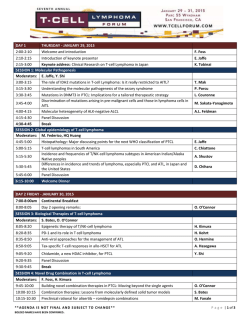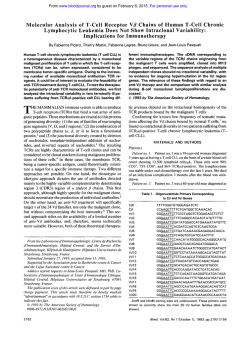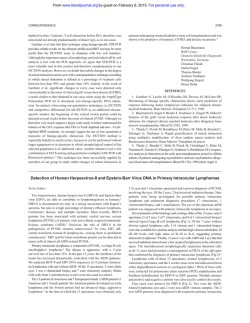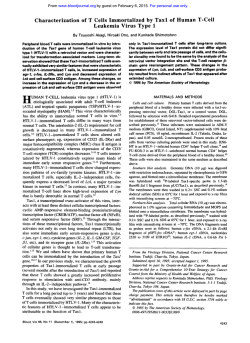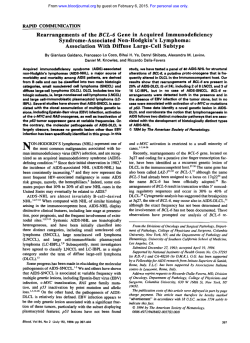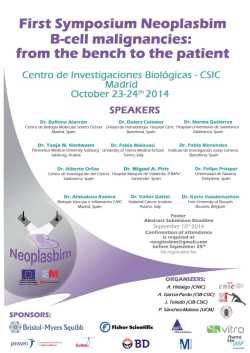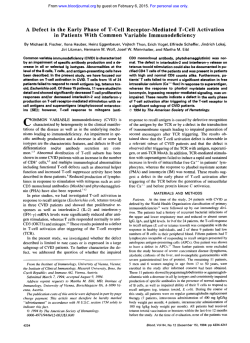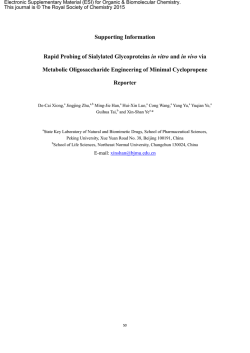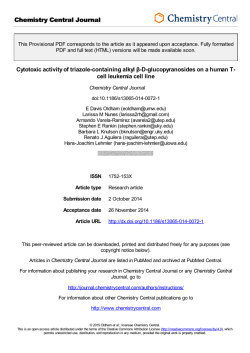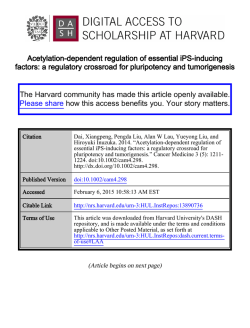
MicroRNA181a is overexpressed in T
1 MicroRNA181a is overexpressed in T-cell leukemia/lymphoma and related to 2 chemoresistance 3 Zi-Xun YAN M.D.,1,2,* Zhong ZHENG M.D.,1,2,* Wen XUE M.D.,1,2,* Ming-Zhe 4 ZHAO M.D.,3,* Xiao-Chun FEI M.D.,4, Li-Li WU M.D.,4, Li-Min HUANG M.D., 5 Ph.D,5 Christophe LEBOEUF Ph.D.,6 Anne JANIN M.D., Ph.D.,6 Li WANG M.D., 6 Ph.D,1,2 Wei-Li ZHAO M.D., Ph.D.1,2 7 * These authors contributed equally to this manuscript. 1 State Key Laboratory of Medical Genomics, Shanghai Institute of Hematology, 8 9 10 Shanghai Rui Jin Hospital, Shanghai Jiao Tong University School of Medicine, 11 Shanghai, China; 12 Génomique, Laboratory of Molecular Pathology, Shanghai, China; 3 Department of 13 Hematology, Central Hospital of Jin Hua, Zhejiang, China; 4 Department of Pathology, 14 Shanghai Rui Jin Hospital, Shanghai Jiao Tong University School of Medicine, 15 Shanghai, China; 5 Department of Oncology, People's Hospital of Guizhou Province, 16 Guiyang, China; 17 Pathologie, U1165 Inserm, F-75010 France 18 Correspondence: Wei-Li ZHAO, Email: [email protected], Li WANG, Email: 19 [email protected], State Key Laboratory of Medical Genomics, Shanghai 20 Institute of Hematology, Shanghai Rui Jin Hospital, 197 Rui Jin Er Road, Shanghai 21 200025, China, Fax: 0086-21-64743206, Tel: 0086-21-64370045. 2 6 Pôle de Recherches Sino-Français en Science du Vivant et Université Paris Diderot, Sorbonne Paris Cité, Laboratoire de 22 1 23 Abstract 24 MicroRNAs (miRs) play an important role in tumorogenesis and chemoresistance in 25 lymphoid malignancies. Comparing with reactive hyperplasia, miR181a was 26 overexpressed in 130 patients with T-cell leukemia/lymphoma, including acute T-cell 27 lymphoblastic leukemia (n=32), T-cell lymphoblastic lymphoma (n=16), peripheral 28 T-cell lymphoma, not otherwise specified (n=45), anaplastic large cell lymphoma 29 (n=15) and angioimmunoblastic T-cell lymphoma (n=22). Irrespective to histological 30 subtypes, 31 phosphorylation. In vitro, ectopic expression of miR181a in HEK-293T cells 32 significantly enhanced cell proliferation, activated AKT and conferred cell resistance 33 to doxorubicin. Meanwhile, miR181a expression was upregulated in Jurkat cells, 34 along with AKT activation, during exposure to chemotherapeutic agents regularly 35 applied 36 cyclophosphamide, cytarabine and cisplatin. Isogenic doxorubicin-resistant Jurkat and 37 H9 cells were subsequently developed, which also presented with miR181a 38 overexpression and cross-resistance to cyclophosphamide and cisplatin. Meanwhile, 39 specific inhibition of miR181a enhanced Jurkat and H9 cell sensitivity to 40 chemotherapeutic agents, further indicating that miR181a was involved in acquired 41 chemoresistance. Collectively, miR181a functioned as a biomarker of T-cell 42 leukemia/lymphoma through modulation of AKT pathway. Related to tumor cell 43 chemoresistance, miR181a could be a potential therapeutic target in treating T-cell 44 malignancies. miR181a to T-cell overexpression was leukemia/lymphoma associated treatment, with such increased as AKT doxorubicin, 2 45 Key words: miR181a, T-leukemia/lymphoma, chemoresistance. 46 3 47 Introduction 48 Malignancies derived from the T-cell lineages encompass a heterogeneous 49 group of neoplasm. The World Health Organization (WHO) classification recognizes 50 distinctive subtypes of immature T-cell malignancies, like acute T-cell lymphoblastic 51 leukemia (T-ALL) and T-cell lymphoblastic lymphoma (T-LBL), as well as mature 52 T-cell malignancies, mainly including peripheral T-cell lymphoma, not otherwise 53 specified 54 angioimmunoblastic T-cell lymphoma (AITL) [1]. Varied from clinicopathological 55 features and biological behavior, they are generally more aggressive than their B-cell 56 counterpart, characterized by resistance to conventional chemotherapy and poor 57 prognosis of the patients [2]. Therefore, biomarkers related to tumor progression and 58 chemoresistance remain to be investigated and may become potential targets for 59 future therapy in T-cell leukemia/lymphoma. (PTCL-NOS), anaplastic large cell lymphoma (ALCL) and 60 MicroRNAs (miRs), a class of 19- to 23-nucleotide non-coding RNA molecules, 61 regulate gene expression by targeting mRNA at the 3’untranslated region (UTRs)[3]. 62 Growing evidences suggested that miRs are critical regulators in tumorogenesis and 63 drug resistance[4, 5]. MiR181 is essential for lymphocyte differentiation and 64 maturation in thymus[6]. More recently, it has been reported that miR181 65 overexpression promotes cell proliferation and activates PI3K/AKT signaling 66 transduction pathway [7, 8]. Activated in lymphoid malignancies[9], AKT plays a 67 pivotal role in tumor progression and resistance to chemotherapeutic agents [10, 11]. 68 Here we assessed miR181a expression, as well as its relation to AKT activation and 4 69 chemoresistance in T-cell leukemia/lymphoma. 70 71 Patients and Methods 72 Patients 73 One hundred and thirty patients diagnosed with T-ALL or T-cell lymphoma were 74 enrolled in this study, including 32 T-ALL, 16 T-LBL, 45 PTCL-NOS, 15 ALCL and 75 22 AITL. Histologic diagnoses were established according to the WHO 76 classification.[1] PTCL cases (PTCL-NOS, ALCL and AITL) were treated with 77 CHOP-based chemotherapy. T-LBL and T-ALL cases were treated with 78 HyperCVAD-A/B regimens as previous reported[12, 13]. Response rates were 79 assessed according to the criteria as reported[12, 13]. The clinicopathological data of 80 the patients was listed in Table 1. Thirty-four age and sex-matched cases with reactive 81 hyperplasia were referred as controls. The study was approved by the Institutional 82 Review Board with informed consent obtained in accordance with the Declaration of 83 Helsinki. 84 85 Cell lines and reagents 86 T-leukemia/lymphoma cell lines Jurkat, H9 and embryonic kidney cell line 87 HEK-293T were available from American Type Culture Collection (Manassas, VA, 88 USA). Doxorubicin-resistant Jurkat and H9 cells were established by exposure to 89 gradually increasing concentrations of doxorubicin in vitro, as described by Huang et 90 al.[14] 5 91 92 Cell proliferation assay 93 Cell proliferation was measured by MTT and EdU incorporation assay. Cells 94 were seeded in 96-well plates and incubated with the indicated concentrations of 95 reagents at 37°C. After 72h incubation, 0.1mg of MTT was added to each well and 96 the absorbance was measured at 490nm by spectrophotometry. EdU assay was 97 conducted using Cell-LightTM EdU imaging kit (RiboBio, Guangzhou, China) 98 according to the manufacturer’s instruction. 99 100 MiR181a detection 101 Total RNA was extracted from 20µm-thick paraffin (n=100) or frozen sections 102 (n=64) using RecoverAllTM total nucleic acid isolation kit or Trizol agent following 103 the manufacturer’s protocol. MiR181a expression was analyzed by real-time 104 quantitative RT-PCR using miRNA reverse transcription kit, hsa-miR 181a assay and 105 7500HT Fast Real-time PCR system (Applied Biosystem, CA, USA). RNU24 was 106 used as endogenous control and Jurkat cells for calibration. A relative quantification 107 was calculated using the ΔΔCT method.[15] 108 109 Western blot 110 Cells were lysed in 200µl lysis buffer (0.5M Tris-HCl, pH 6.8, 2mM EDTA, 10% 111 glycerol, 2% SDS and 5% β-mercaptoethanol). Protein extracts (20µg) were 112 electrophoresed on 10% SDS polyacrylamide gels and transferred to nitrocellulose 6 113 membranes. Membranes were blocked with 5% non-fat dried milk in Tris-buffered 114 saline and incubated for 2h at room temperature with appropriate primary antibody, 115 followed 116 immunocomplexes were visualized using chemiluminescence phototope-horseradish 117 peroxidase kit. Actin was used to ensure equivalent protein loading. Antibodies 118 against phosphorylated-AKT (p-AKT), AKT, Actin and chemiluminescence 119 phototope-horseradish-peroxidase kit were obtained from Cell Signaling (Beverly, 120 MA, USA). Anti-PTEN antibody was from Abcam (Cambridge, UK). Horseradish 121 peroxidase-conjugated goat anti-mouse-IgG and goat anti-rabbit-IgG antibodies were 122 from Santa Cruz Biotechnology (Santa Cruz, CA, USA). by horseradish peroxidase-conjugated secondary antibody. The 123 124 Cell transfection 125 HEK-293T cells were incubated with pEZX-181a vector (HmiR0292-MR03) or 126 a control vector pEZX-ct (CmiR0001-MR03, Genecopia, MD, USA) and 127 lipofectamine 2000 (Invitorgen, CA, USA) for 24h and replaced in fresh medium for 128 further experiments. To inhibit miR181a expression, Jurkat and H9 cells were 129 transfected with 10nM antagomir using lipofectamine 2000 (Invitorgen) for 24h. The 130 miR181a antagomir and the negative control were synthesized by Shanghai Biotend 131 Biotechnologies Co., Ltd (Shanghai, China). 132 133 Immunohistochemistry assay Immunohistochemistry was performed on 5µm-paraffin sections with an indirect 134 7 135 immunoperoxidase method using antibodies against p-AKT (Cell Signaling). 136 Expression levels were scored semi-quantitatively based on percentage of positive 137 cells: +, <25%; ++, 25-49%; +++, 50-74%; ++++, 75-100%. 138 139 Statistical analysis 140 Differences of miR181a expression among groups were assessed using 141 Mann-Whitney U test. The association between miR181a and p-AKT expression in 142 human tumor samples was analyzed by Fisher’s exact test. In vitro experimental 143 results were expressed as mean±S.D. of data obtained from three separate experiments 144 and determined using t-test to compare variance. P<0.05 was considered statistically 145 significant. 146 147 Results 148 MiR181a was overexpressed in T-cell leukmia/lymphoma and related to AKT 149 activation. 150 Compared with reactive hyperplasia, miR181a was overexpressed in T-cell 151 leukemia/lymphoma (P<0.0001, Figure 1A). No significant difference was observed 152 among T-ALL and subtypes of T-cell lymphoma (P=0.5153, Figure 1B). 153 The median value of relative miR181a expression in T-cell leukemia/lymphoma 154 was 2136. The patients with miR181a expression level over and equal to the median 155 value were regarded as high miR181a expression, whereas those below the median 156 value were included in the low miR181a expression. Patients with high miR181a 8 157 expression had significantly lower overall response rate (ORR) than those with low 158 miR181a 159 immunohistochemistry in primary tumor sections of 12 T-cell lymphoma patients (6 160 cases from high miR181a expression group and 6 cases from low miR181a expression 161 group, Figure 2A). High miR181a expression was associated with increased positivity 162 of p-AKT (P=0.0152, Figure 2B). expression (Table 1). P-AKT expression was detected by 163 164 MiR181a promoted cell proliferation and induced chemoresistance through 165 activating AKT. 166 T-leukemia/lymphoma cell lines Jurkat and H9 possessed higher levels of 167 miR181a expression than that of HEK-293T cells (P=0.0023 and P=0.0030, 168 respectively, Figure 3A). To gain insight into the biological function of miR181a, 169 HEK-293T cells, with lowest miR181a expression, were transiently transfected with 170 miR181a (pEZX-181a, Figure 3B). Ectopic expression of miR181a remarkably 171 accelerated cell growth, as compared to the control cells (pEZX-ct). In parallel with 172 increased cell proliferation, the percentage of EdU-positive cells was significantly 173 higher in pEZX-181a cells (52.7%±8.7%) than in pEZX-ct cells (20.7%±7.0%, 174 P=0.0458, Figure 3C). Of note, overexpression of miR181a increased AKT 175 phosphorylation, while the total protein level remained constant (Figure 3D). AKT is 176 the key regulator of cell proliferation and drug resistance.[11, 16] Accordingly, the 177 IC50 of doxorubicin was significantly increased in the miR181a-overexpressing 178 HEK-293T cells, as compared to the control cells (21.3±3.1 nM vs 9.8±2.3 nM, 9 179 P=0.0260, Figure 3E). 180 181 MiR181a overexpression 182 T-leukemia/lymphoma cells. corresponded to chemoresistance in 183 Doxorubicin (DOX), cyclophosphamide (CTX), cytarabine (Ara-C) and 184 cisplatin are main chemotherapeutic agents used in treating T-cell malignancies. 185 When Jurkat cells were exposed to these agents for 48h, miR181a expression was 186 significantly increased (P=0.0019, P=0.0016, P=0.0172, and P<0.0001, respectively, 187 Figure 4A), in according with increased AKT phosphorylation detected by Western 188 blot (Figure 4B). 189 Acquired drug resistance is an important obstacle that impairs the success of 190 cancer treatment. Isogenic doxorubicin-resistant sublines were developed as 191 previously reported [14, 17], at the concentrations of 7.5nM (Jurkat/7.5nM DOX) and 192 15nM (Jurkat/15nM DOX) in Jurkat cells, as well as 5nM (H9/5nM DOX) and 10nM 193 (H9/10nM DOX) in H9 cells. Compared with the parental cells (Jurkat cells, 44.3± 194 4.0 nM, H9 cells, 14.7±5.5 nM), IC50 of doxorubicin was significantly increased in 195 Jurkat/7.5nM DOX and Jurkat/15nM DOX cells (70.1±8.0 nM and 100.0±8.0 nM, 196 P=0.0453 and P=0.0152, respectively, Figure 4C), and in H9/5nM DOX and 197 H9/10nM DOX cells (28.0±4.3 nM and 41.3±4.7 nM, P=0.0481 and P=0.0443, 198 respectively, Figure 4D). Accordingly, levels of miR181a expression were 199 significantly higher in doxorubicin-resistant cells than in the parental cells (1.8±0.2 200 fold in Jurkat/7.5nM DOX and 2.8±0.3 fold in Jurkat/15nM DOX cells, P=0.0253 10 201 and P=0.0112, Figure 4E, 2.1±0.6 fold in H9/5nM and 3.4±0.2 fold in H9/10nM 202 DOX cells, P=0.0384 and P=0.0032, respectively, Figure 4F), consistent with AKT 203 activation (Figure 4G and 4H). Increased miR181a expression was linked to AKT 204 phosphorylation, not only in PTEN-negative Jurkat cells[18], but also in 205 PTEN-positive H9 cells (Figure 4G and 4H). Therefore, regulation of AKT 206 phosphorylation 207 leukemia/lymphoma. Further drug-sensitivity test showed that these resistant sublines 208 with miR181a overexpression also had cross-resistance to other chemotherapeutic 209 agents (Table 2). Therefore, exposure to chemotherapeutic agents could induce 210 miR181a expression and AKT activation, which is closely related to acquired 211 chemoresistance. could be independent on PTEN expression in T-cell 212 213 MiR181a inhibition enhanced 214 chemotherapeutic agents T-leukemia/lymphoma cell sensitivity to 215 Specific inhibition of miR181a in Jurkat and H9 cells as well as their resistant 216 sublines, using an antagomir, significantly increased cell sensitivity to doxorubicin 217 (Figure 5A and 5B) and decreased AKT phosphorylation (Figure 5C and 5D). Similar 218 as doxorubicin, decreased miR181a expression was also related to reduced IC50 of 219 cisplatin and cyclophosphamide in doxorubicin-resistant Jurkat and H9 cells (Table 220 3). 221 222 Discussion 11 223 In addition to genetic abnormalities, epigenetic aberrations, particularly those of 224 miRs, participate in human carcinogenesis [5, 19]. MiR181a is critically involved in 225 hematological malignancies. In acute myelogenous leukemia, increased miR181a 226 expression was significantly associated with a higher complete remission rate of the 227 patients[20]. However, as recently reported in lymphoid malignancies like acute 228 lymphoblastic leukemia and multiple myeloma, miR181 overexpression was related 229 to advanced stage and tumor progression[7, 21]. In according with malignant T cells, 230 miR181a is upregulated in normal T-cell counterpart and miR181a/b-deficient mice 231 show severe defects in T-cell development[6, 8]. Therefore, miR181 may have 232 different roles in hematological malignancies. Our study showed that miR181a, 233 independent on histological subtypes, was overexpressed and these patients were less 234 responded to treatment, referring miR181a as a common biomarker of 235 chemoresistance in T-cell leukemia/lymphoma. 236 Chemoresistance, determining therapeutic effect and clinical outcome of the 237 patients, is one of the control factors in cancer treatment, including T-cell 238 leukemia/lymphoma [22]. Here miR181a was closely related to chemoresistance in 239 T-leukemia/lymphoma. This was consistent with previous reports in B-cell lymphoma 240 that high expression of miR181 could lead to decreasing proapoptotic protein Bim and 241 increasing resistance to chemotherapy [23]. AKT is a key tuning point in tumor cell 242 growth and chemosensitivity [24, 25]. MiR181 is a central regulator of PI3K pathway, 243 since miR181a/b-deficient mice showed severe defects in lymphoid development and 244 T-cell homeostasis associated with impaired PI3K/AKT cascade [8]. As mechanism 12 245 of action, miR181 targets PTPN, DUSP5, DUSP6, resulting in PI3K/AKT activation 246 and tumorogenesis in murine T-cell leukemia [7, 8]. Our results showed that ectopic 247 expression of miR181a leads to AKT phosphorylation, enhancing cell proliferation 248 and inducing cell resistance to chemotherapy in T-cell leukemia/lymphoma. This 249 correlation of miR181a overexpression with AKT activation was not only observed in 250 cell lines, but also in primary tumor samples of patients with T-leukemia/lymphoma. 251 Apart from primary chemoresistance, acquired chemoresistance is also an important 252 factor of treatment failure. MiR181a expression of Jurkat cells was significantly 253 upregulated after exposure to chemotherapeutic agents and linked to increased AKT 254 phosphorylation. Meanwhile, isogenic doxorubicin-resistant cell lines were developed, 255 which 256 chemotherapeutic drugs. The relative resistance to chemotherapeutic agents was along 257 with increased miR181a expression and subsequent AKT activation, further 258 confirming that miR181a induced AKT activation and contributed to chemoresistance 259 in T-cell leukemia/lymphoma. were resistant to doxorubicin and had cross-resistance to other 260 261 Conclusions 262 MiR181a was involved in T-cell leukemia/lymphoma through modulation of 263 AKT pathway. Functioned as a critical regulator of chemosensitivity, miR181a could 264 thus be a promising therapeutic target in treating T-cell malignancies resistant to 265 chemotherapy. 266 13 267 Conflicts of Interest 268 The authors declare no conflict of interest. 269 270 Acknowledgements 271 This work was supported, in part, by the National Natural Science Foundation of 272 China (81172254, 81101793 and 81325003), Innovation Fund Projects of Shanghai 273 Jiao Tong University (BXJ201312), the Shanghai Commission of Science and 274 Technology (11JC1407300, 14430723400, and 14140903100), and the Program of 275 Shanghai Subject Chief Scientists (13XD1402700). 276 277 Reference 278 1. ES Jaffe: The 2008 WHO classification of lymphomas: implications for clinical 279 practice and translational research, Hematology Am Soc Hematol Educ Program 2009, 280 523-531 281 2. WL Zhao: Targeted therapy in T-cell malignancies: dysregulation of the cellular 282 signaling pathways, Leukemia 2009, 24:13-21 283 3. D Lee, C Shin: MicroRNA-target interactions: new insights from genome-wide 284 approaches, Ann N Y Acad Sci 1271:118-128 285 4. JW Kim, S Mori, JR Nevins: Myc-induced microRNAs integrate Myc-mediated 286 cell proliferation and cell fate, Cancer Res 2010, 70:4820-4828 287 5. HY Jin, H Oda, M Lai, RL Skalsky, K Bethel, J Shepherd, SG Kang, WH Liu, M 288 Sabouri-Ghomi, BR Cullen, K Rajewsky, C Xiao: MicroRNA-17~92 plays a 289 causative role in lymphomagenesis by coordinating multiple oncogenic pathways, 290 Embo J 2013, 32:2377-2391 291 6. CZ Chen, L Li, HF Lodish, DP Bartel: MicroRNAs modulate hematopoietic 292 lineage differentiation, Science 2004, 303:83-86 293 7. R Fragoso, T Mao, S Wang, S Schaffert, X Gong, S Yue, R Luong, H Min, Y 14 294 Yashiro-Ohtani, M Davis, W Pear, CZ Chen: Modulating the strength and threshold 295 of NOTCH oncogenic signals by mir-181a-1/b-1, PLoS Genet 2012, 8:e1002855 296 8. J Henao-Mejia, A Williams, LA Goff, M Staron, P Licona-Limon, SM Kaech, M 297 Nakayama, JL Rinn, RA Flavell: The microRNA miR-181 is a critical cellular 298 metabolic rheostat essential for NKT cell ontogenesis and lymphocyte development 299 and homeostasis, Immunity 2013, 38:984-997 300 9. WY Shi, D Xiao, L Wang, LH Dong, ZX Yan, ZX Shen, SJ Chen, Y Chen, WL 301 Zhao: Therapeutic metformin/AMPK activation blocked lymphoma cell growth via 302 inhibition of mTOR pathway and induction of autophagy, Cell Death Dis 2012, 303 3:e275 304 10. KF Chen, HL Chen, WT Tai, WC Feng, CH Hsu, PJ Chen, AL Cheng: Activation 305 of phosphatidylinositol 3-kinase/Akt signaling pathway mediates acquired resistance 306 to sorafenib in hepatocellular carcinoma cells, J Pharmacol Exp Ther 2011, 307 337:155-161 308 11. C Knuefermann, Y Lu, B Liu, W Jin, K Liang, L Wu, M Schmidt, GB Mills, J 309 Mendelsohn, Z Fan: HER2/PI-3K/Akt activation leads to a multidrug resistance in 310 human breast adenocarcinoma cells, Oncogene 2003, 22:3205-3212 311 12. HM Kantarjian, S O'Brien, TL Smith, J Cortes, FJ Giles, M Beran, S Pierce, Y 312 Huh, M Andreeff, C Koller, CS Ha, MJ Keating, S Murphy, EJ Freireich: Results of 313 treatment with hyper-CVAD, a dose-intensive regimen, in adult acute lymphocytic 314 leukemia, J Clin Oncol 2000, 18:547-561 315 13. DA Thomas, S O'Brien, J Cortes, FJ Giles, S Faderl, S Verstovsek, A Ferrajoli, C 316 Koller, M Beran, S Pierce, CS Ha, F Cabanillas, MJ Keating, H Kantarjian: Outcome 317 with the hyper-CVAD regimens in lymphoblastic lymphoma, Blood 2004, 318 104:1624-1630 319 14. L Huang, C Perrault, J Coelho-Martins, C Hu, C Dulong, M Varna, J Liu, J Jin, C 320 Soria, L Cazin, A Janin, H Li, R Varin, H Lu: Induction of acquired drug resistance in 321 endothelial cells and its involvement in anticancer therapy, J Hematol Oncol 2013, 322 6:49 323 15. DJ Min, T Ezponda, MK Kim, CM Will, E Martinez-Garcia, R Popovic, V 15 324 Basrur, KS Elenitoba-Johnson, JD Licht: MMSET stimulates myeloma cell growth 325 through microRNA-mediated modulation of c-MYC, Leukemia 2012, 27:686-694 326 16. X Zhu, Z He, J Wu, J Yuan, W Wen, Y Hu, Y Jiang, C Lin, Q Zhang, M Lin, H 327 Zhang, W Yang, H Chen, L Zhong, Z She, S Chen, Y Lin, M Li: A marine 328 anthraquinone SZ-685C overrides adriamycin-resistance in breast cancer cells through 329 suppressing Akt signaling, Mar Drugs 2012, 10:694-711 330 17. WJ Li, SL Zhong, YJ Wu, WD Xu, JJ Xu, JH Tang, JH Zhao: Systematic 331 expression analysis of genes related to multidrug-resistance in isogenic docetaxel- and 332 adriamycin-resistant breast cancer cell lines, Mol Biol Rep 2013, 40:6143-6150 333 18. M Freeley, J Park, KJ Yang, RL Wange, Y Volkov, D Kelleher, A Long: Loss of 334 PTEN expression does not contribute to PDK-1 activity and PKC activation-loop 335 phosphorylation in Jurkat leukaemic T cells, Cell Signal 2007, 19:2444-2457 336 19. ZX Yan, LL Wu, K Xue, QL Zhang, Y Guo, M Romero, C Leboeuf, A Janin, SJ 337 Chen, L Wang, WL Zhao: MicroRNA187 overexpression is related to tumor 338 progression and determines sensitivity to bortezomib in peripheral T-cell lymphoma, 339 Leukemia 2014, 28:880-887 340 20. S Schwind, K Maharry, MD Radmacher, K Mrozek, KB Holland, D Margeson, 341 SP Whitman, C Hickey, H Becker, KH Metzeler, P Paschka, CD Baldus, S Liu, R 342 Garzon, BL Powell, JE Kolitz, AJ Carroll, MA Caligiuri, RA Larson, G Marcucci, 343 CD Bloomfield: Prognostic significance of expression of a single microRNA, 344 miR-181a, in cytogenetically normal acute myeloid leukemia: a Cancer and Leukemia 345 Group B study, J Clin Oncol 2010, 28:5257-5264 346 21. C Bi, WJ Chng: MicroRNA: important player in the pathobiology of multiple 347 myeloma, Biomed Res Int 2014, 2014:521586 348 22. WL Zhao: Targeted therapy in T-cell malignancies: dysregulation of the cellular 349 signaling pathways, Leukemia 2010, 24:13-21 350 23. T Lwin, J Lin, YS Choi, X Zhang, LC Moscinski, KL Wright, EM Sotomayor, 351 WS Dalton, J Tao: Follicular dendritic cell-dependent drug resistance of non-Hodgkin 352 lymphoma involves cell adhesion-mediated Bim down-regulation through induction 353 of microRNA-181a, Blood 2010, 116:5228-5236 16 354 24. LS Steelman, SL Abrams, J Whelan, FE Bertrand, DE Ludwig, J Basecke, M 355 Libra, F Stivala, M Milella, A Tafuri, P Lunghi, A Bonati, AM Martelli, JA 356 McCubrey: Contributions of the Raf/MEK/ERK, PI3K/PTEN/Akt/mTOR and 357 Jak/STAT pathways to leukemia, Leukemia 2008, 22:686-707 358 25. DA Fruman, C Rommel: PI3K and cancer: lessons, challenges and opportunities, 359 Nat Rev Drug Discov 2014, 13:140-156 360 361 362 17 363 Figure Legends 364 Figure 1. MiR181a was overexpresssed in T-cell leukemia/lymphoma. 365 A. As detected by real-time quantitative PCR, miR181a was overexpressed in T-cell 366 malignancies. ***, P<0.001 comparing with reactive hyperplasia. The relative 367 expression level of each patient was calculated based on the lowest expression value. 368 B. MiR181a was overexpressed in acute T-cell lymphoblastic leukemia (T-ALL, 369 n=32), as well as subtypes of T-cell lymphoma, including T-cell lymphoblastic 370 lymphoma (T-LBL, n=16), peripheral T-cell lymphoma, not otherwise specified 371 (PTCL-NOS, n=45), anaplastic large cell lymphoma (ALCL, n=15), and 372 angioimmunoblastic T-cell lymphoma (AITL, n=22). 373 374 Figure 2. MiR181a overexpression was related to AKT activation in T-cell 375 leukemia/lymphoma. 376 As revealed by immunohistochemistry (A), increased positivity of p-AKT was 377 observed in primary tumor samples of T-cell lymphoma patients with high miR181a 378 expression (n=6), compared to those with low miR181a expression (n=6) (B). *, 379 P<0.05 comparing with low miR181a expression. Bar=50 µm. 380 381 Figure 3. Ectopic expression of miR181a enhanced cell proliferation and 382 resistance to doxorubicin through AKT activation. 383 A. T-leukemia/lymphoma Jurkat and H9 cells had significantly higher expression 384 levels of miR181a than that of HEK-293T cells. **, P<0.01 comparing with 18 385 HEK-293T cells. B. Transfection with miR181a (pEZX-181a) in HEK-293T cells 386 resulted in significantly increased miR181a expression. **, P<0.01 comparing with 387 the control pEZX-ct cells. C. EdU incorporation assay in HEK-293T cells showed that 388 miR181a-overexpressing pEZX-181a cells presented with increased EdU-positive 389 cells. *, P<0.05, comparing with the control pEZX-ct cells. Bar=20µm. D. 390 Overexpression of miR181a increased AKT phosphorylation, while the total protein 391 level remained constant. E. IC50 of doxorubicin was significantly higher in the 392 pEZX-181a cells than in the control pEZX-ct cells. *, P<0.05 comparing with the 393 control pEZX-ct cells. 394 395 Figure 4. Exposure of T-leukemia/lymphoma cells to chemotherapeutic agents 396 upregulated miR181a expression and resulted in AKT activation. 397 A. When Jurkat cells were treated with chemotherapeutic agents for 48h, miR181a 398 expression was significantly increased. CON, untreated; DOX, doxorubicin; CTX, 399 cyclophosphamide; Ara-C, cytarabine. *, P<0.05, **, P<0.01; ***, P<0.001 400 comparing with the CON cells. B. In accordance with miR181a upregulation, 401 increased AKT phosphorylation was observed by western blot, while the total protein 402 level remained constant. C and D. IC50 of doxorubicin was significantly increased in 403 doxorubicin-resistant Jurkat (C) and H9 (D) cells. E and F. MiR181a expression was 404 significantly increased in doxorubicin-resistant Jurkat (E) and H9 (F) cells. CON, 405 untreated, *, P<0.05, **, P<0.01 comparing with the CON cells. G and H. P-AKT 406 expression was significantly increased in doxorubicin-resistant Jurkat (G) and H9 (H) 19 407 cells. 408 409 Figure 410 T-leukemia/lymphoma cells and resistant sublines sensitivity to doxorubicin, 411 along with p-AKT downregulation. 412 A and B. IC50 of doxorubicin was significantly decreased in antagomir-treated Jurkat 413 (A) and H9 (B) cells. **, P<0.01, ***, P<0.001 comparing with the control cells. C 414 and D: Decreased AKT phosphorylation was found in miR181a antagomir-treated 415 Jurkat (C) and H9 (D) cells. 5. Speicific inhibition of miR181a expression could increase 20 Figure 1 A B MiR181a expression MiR181a expression p -A K T e xp re ssio n 100 80 60 40 20 0 TL AI L C AL 66 % 83 % 17 % 17 % p-AKT positive cells ++++ +++ ++ + Lo w h m 1a 1a 18 18 iR iR m S 17 % ig Low miR181a n=6 LN TL PT C * H High miR181a n=6 O LL Figure 2 B Patients (%) A Re a ctive h yp e rp la sia n =3 4 TA T-ce ll ma lig n a n cie s n =1 3 0 BL Relative miR181a levels Relative miR181a levels *** 21 Figure 3 A B HE K -2 9 3 T 20 ** ** 10 0 HE K -2 9 3 T H9 C 0 p E Z X - ct p E Z X- 1 8 1a Ju rka t Ove rla y pEZ X - 181a pE ZX - ct EdU E d U p o sitive ce lls pEZX- 181a pEZ X - ct D HE K -2 9 3 T E 50 AKT β - a ctin IC50 ( nM) p -A K T * 0 50 100 Percentage( % ) HE K 2 9 3 T p E Z X - ct p E Z X- 1 8 1a 10 E d U in co rp o ra tio n a ssa y DA P I ** 20 Relative miR18 1a levels Relative miR18 1a levels MiR1 8 1a e xp re ssio n in ce ll lin e s * 25 0 p E Z X - ct p E Z X- 1 8 1a 22 Figure 4 B Relative miR181a levels ** 8 A at C is pl -C ra TX O O X N *** C ** * C 12 Ju rka t in Ju rka t MiR1 8 1 a e x p r e s s i o n ( 4 8 h ) D A p -A K T AKT 4 β-actin 0 CON C DOX CT X A ra -C Cisp la tin D G IC50 in H9 Ju rka t ol 2 X X DO ol on tr ** * O X H9 C 4 p-AKT 2 PTEN 0 DO X X 15 nM 75 nM DO ol tr on nM 15 nM 75 C DO X DO ol tr on X β-actin C nM nM M 10 H MiR181a in H9 Relative miR181a levels * * β-actin D F MiR181a in Jurkat 4 DO ol C 5n 75 15 nM nM on tr DO DO X ol tr on C X 0 E 15 PTEN nM 0 Relative miR181a levels tr p-AKT 25 10 75 on * * * 50 C * IC50 (nM) IC50 (nM) 150 D O X IC50 in Jurkat 23 Figure 5 A IC 50 in Jurkat Jurkat ** DOX-resistant Jurkat *** 150 100 50 0 H9 150 DOX-resistant H9 ** * ** 100 50 D β - a c tin β - a c tin ag l p -A K T An t tro on C p -A K T om ir H9 om ir ag An t on tro l J u rk a t C An ta go m ir 10 nM D O X An ta go m ir C on tro l An ta go m ir 15 nM D O X An ta go m ir C on tro l 0 C IC 50 in H9 IC 50 (nM) IC 50 (nM) 200 B 24 Table 1 Clinicopathological characteristics of 130 patients with T-cell leukemia/lymphoma High miR181a Low miR181a expression Expression (n=65) (n=65) ≥60 13 17 <60 52 48 Male 42 32 Female 23 33 Normal 19 23 Above normal 46 42 T-ALL 15 17 T-LBL 8 8 PTCL-NOS 22 23 ALCL 6 9 AITL 14 8 Characteristics P value Age (years) 0.5328 Gender 0.1106 Lactic dehydrogenase level (LDH) 0.5740 Pathological subtypes 0.6656 International prognostic index (IPI) Low 12 11 Low/intermediate 23 33 Intermediate/high 20 15 High 10 6 38 50 Overall response (CR+PR) 0.3152 0.0385 * CR, complete remission; PR, partial remission Table 2 Cross-resistance of doxorubicin-resistant cells to other chemotherapeutic agents IC50 Agents Jurkat IC50 Doxorubicin resistant-Jurkat P value H9 Doxorubicin resistant-H9 P value Cisplatin (uM) 6.2± 0.3 9.0±0.4 0.0039 5.7±0.3 8.5± 0.5 0.0067 Cyclophosphamide (mM) 3.3±0.2 4.8±0.2 0.0056 2.4±0.2 3.9±0.3 0.0106 25 (mM) Cyclophosphamid (uM) Cisplatin Agents 3.3±0.2 1.6±0.2 5.1±0.1 Antagomir Control 6.6±0.2 Jurkat Jurkat IC50 0.0018 0.0014 Value P 4.8±0.2 3.6±0.2 7.0±0.4 t Antagomir Control 9.0±0.4 resistant-Jurka Doxorubicin resistant-Jurkat Doxorubicin IC50 0.0214 0.0215 Value P 2.4±0.2 5.7±0.3 Control H9 H9 0.9±0.1 4.4±0.2 Antagomir IC50 0.0019 0.0264 Value P 3.9±0.3 8.5±0.5 Control resistant-H9 2.5±0.2 6.0±0.5 Antagomir resistant-H9 Doxorubicin IC50 Doxorubicin Table 3 Inhibition miR181a expression sensitized T-leukemia/lymphoma cells to chemotherapeutic agents 0.0134 0.0191 Value P 26
© Copyright 2026
